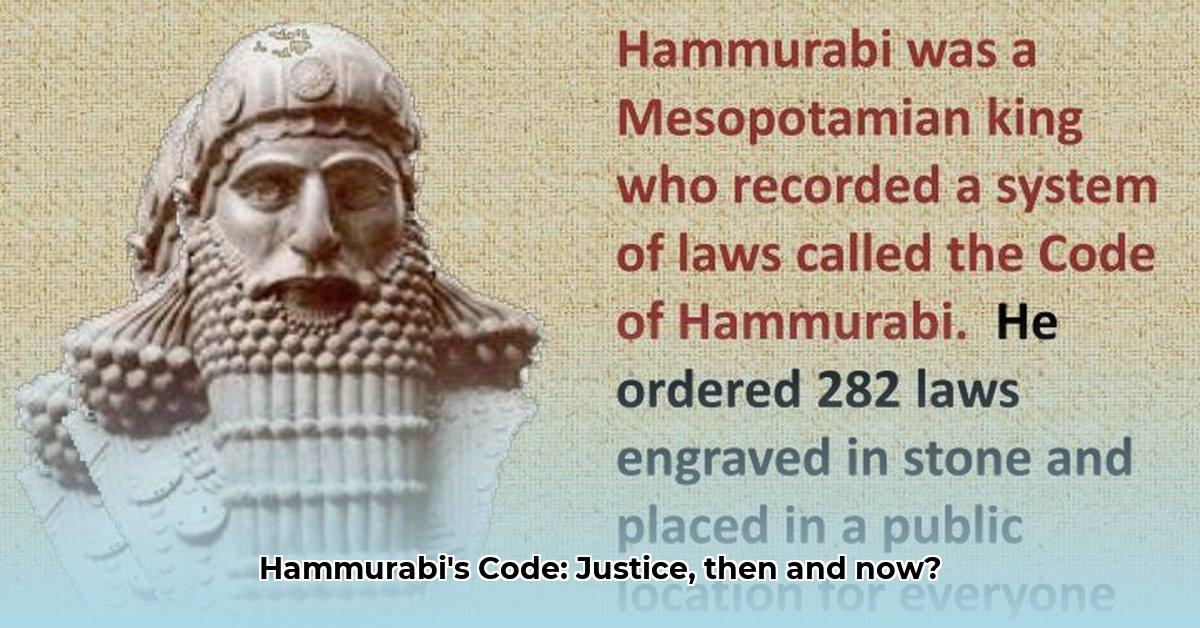Imagine a world where disputes were settled by brute force. Then, picture a society over 3,800 years ago developing a comprehensive legal code etched in stone – the Code of Hammurabi. This code offers a window into ancient Babylonian life, revealing everything from family disputes to business disagreements and their corresponding punishments. We’ll explore how this “eye-for-an-eye” code regulated daily life, the profound impact it had on Babylonian society, and the surprisingly relevant echoes it still holds in our modern legal concepts. For more on ancient legal mysteries, check out this fascinating article on Benjamin Franklin’s letter.
The Code of Hammurabi: An Ancient Blueprint for Legal Systems
Journey back to ancient Mesopotamia, where the Code of Hammurabi was meticulously inscribed on durable stone. More than just a list of rules, it was a detailed snapshot of Babylonian society in the 18th century BCE, reflecting their values, social structure, and the role of law in maintaining order.
Life in Ancient Babylon: A Society Governed by Law
Envision sun-baked brick houses lining bustling marketplaces, and witness elaborate religious ceremonies playing out against the backdrop of a thriving civilization. To ensure stability and resolve conflicts, Babylon needed a system to maintain order. Before Hammurabi, laws were often inconsistent, varying by region and circumstance, leading to confusion and injustice. Hammurabi unified his kingdom’s legal framework by commissioning what is considered the first comprehensive, codified legal system, designed to minimize arbitrary decisions and establish a sense of predictability within society. This act was revolutionary for its time. How did Hammurabi’s Code contribute to the unification and governance of Babylonian society?
“An Eye for an Eye”: Retribution or Restraint?
The phrase “an eye for an eye,” derived from lex talionis (the law of retaliation), is the most widely recognized aspect of Hammurabi’s Code. Was it simply about enacting revenge? Many historians contend that it served to limit the scope of vengeance. Rather than promoting uncontrolled retaliation, the code sought to provide structured, proportional responses to crimes, thereby preventing escalation of conflict. In a society lacking a sophisticated police force, a system of “proportional punishment” acted as a potent deterrent. The potential of facing a similar injury for an assault served as a clear motivation for individuals to avoid committing such offenses.
Class and Justice: Inequality Before the Law
Hammurabi’s Code did not treat all members of society equally. Justice was often dispensed differently based on social class. A nobleman who assaulted a commoner, for instance, typically faced a more severe punishment than if the roles were reversed. This disparity reflected the rigidly hierarchical structure of Babylonian society, where the elite held considerable power and influence. This societal hierarchy is reflected throughout the code, influencing the application and severity of legal consequences.
Beyond Retribution: The Code’s Broader Legal Scope
The Code extended its reach far beyond simple retribution, regulating various aspects of Babylonian life. It established laws governing family affairs, such as marriage (the formal union of two individuals), divorce (the legal termination of a marriage), and inheritance (the distribution of property and assets after death). It also detailed rules pertaining to property ownership, business transactions, and even debt. Furthermore, it included provisions for crop failure and debt forgiveness during times of famine, demonstrating a concern for social welfare. By regulating these numerous facets of daily existence, the code demonstrated the active involvement of the state in both social and economic matters.
The Mechanics of Justice: “If-Then” Reasoning and Divine Judgment
Hammurabi’s Code employed a sophisticated “if-then” structure of legal reasoning, where many laws were presented as conditional statements: “If X happens, then Y shall be the consequence.” For instance, “If a builder constructs a house, and the house collapses and kills the owner, the builder shall be put to death.” This system established a clear and predictable relationship between actions and their consequences. Religious elements also played a role in administering justice, with “ordeals” (severe trials), such as trial by water, being used to determine guilt or innocence in certain cases, illustrating the intertwining of religious beliefs with legal proceedings.
Hammurabi’s Enduring Influence
While not the first legal code in history, Hammurabi’s Code stands out for its comprehensiveness and the lasting influence it has exerted on subsequent legal systems. Legal historians frequently draw parallels between the principles articulated in Hammurabi’s Code and legal developments that followed centuries later, demonstrating its enduring relevance.
Unresolved Questions and Ongoing Research
Despite the wealth of insights it provides, questions regarding Hammurabi’s Code persist. How effectively was it enforced in practice? Did it truly lead to a more just society, or did it primarily serve the interests of the ruling elite? Contemporary scholarship continues to explore these questions, highlighting the ever-evolving nature of historical interpretation and our understanding of ancient societies.
The Code of Hammurabi offers a fascinating glimpse into ancient Babylonian life and their pursuit of justice. While its “eye for an eye” principle may seem harsh by modern standards, its enduring impact on legal systems throughout history is undeniable. Studying this ancient legal text prompts us to reflect on the evolution of justice, its intricate relationship with societal values, and how concepts of fairness change over time. Ongoing research into the Code ensures that our understanding of this foundational legal document continues to evolve, offering new perspectives on the complexities of ancient societies.
How Did Social Class Shape Justice in Hammurabi’s Code?
Let’s delve into the complexities of justice in ancient Babylon. Hammurabi’s Code stands as a crucial testament to early attempts at codified law, offering invaluable insights into the legal and social structures of the time. But to what extent was justice truly impartial in ancient Mesopotamia? Examining the distinctions in social class is essential to understanding the Code’s implications and how it functioned in practice.
A Society Divided: The Babylonian Social Hierarchy
Babylonian society was characterized by a rigid social hierarchy, with three primary classes: the awilu (free, upper class citizens), the mushkenu (free, but of lower status, often engaged in skilled labor), and the wardu (slaves). This hierarchical structure profoundly influenced how the law was applied to different individuals.
Disparities in Justice: The Impact of Social Standing
The Code was not administered without bias. Punishments varied considerably based on social standing. An awilu who assaulted another awilu might face a fine, while an awilu who assaulted a mushkenu or wardu faced significantly less severe penalties. These disparities reflected the inherent bias within the system, where the elite were afforded greater protection and privilege. Conversely, the same crime committed against an awilu by a member of a lower class often resulted in harsher repercussions.
“An Eye for an Eye”: A Reality Filtered Through Class
The principle of “an eye for an eye,” or lex talionis, was not applied uniformly across all social classes. The severity of the punishment was frequently contingent upon the social status of both the victim and the perpetrator. While the principle ostensibly aimed for proportionality and retribution, its practical application revealed a clear bias toward the elite, suggesting that the value of justice was not consistently applied across the social spectrum.
Concrete Examples of Class-Based Disparities
To illustrate the impact of social class on legal outcomes, consider the following examples:
- Theft: Stealing from an awilu carried a significantly heavier penalty than stealing from a mushkenu, reflecting the belief that the loss to an awilu was more detrimental to society’s stability.
- Assault and Injury: Physical assaults resulted in vastly different consequences depending on the class of the participants. The same act of violence, depending on the social standing of those involved, could lead to a fine, mutilation, or even death, underscoring the profound impact of social hierarchy on the administration of justice.
Beyond Class: The Influence of Gender on Legal Outcomes
Social class was not the sole determinant of legal outcomes. Gender also played a significant role, with women often facing different treatment under the law. Although the Code acknowledged women’s right to own property, it often subjected them to harsher punishments than men for similar offenses, further highlighting the complex interplay of social factors in shaping legal outcomes.
The Code’s Legacy: A Step Towards Codified Law
Hammurabi’s Code represents a significant advancement towards codified law, as it established a framework for legal processes and provided a written set of rules. Its legacy challenges us to consider the complexities of early legal systems and their relationship to social structures. By examining the inequalities embedded within the Code, we can gain insights into the evolution of justice and the ways in which legal systems have historically reflected and reinforced social hierarchies, shedding light on the ongoing pursuit of fairness and equality in the administration of law.
Key Takeaways:
- Hammurabi’s Code favored the elite, reflecting the existing social hierarchy in Babylonian society.
- Punishments varied significantly based on social class (awilu, mushkenu, wardu), highlighting the unequal application of justice.
- The principle of “an eye for an eye” was not applied equally, with the social status of the victim and perpetrator influencing the severity of the punishment.
- The Code’s lasting impact lies in its role in establishing formal legal structures, even amidst inherent inequalities.
- Gender also influenced legal outcomes, contributing to further disparities in the administration of justice.
Hammurabi’s Code: A Comparative Analysis Within Near Eastern Legal Traditions
Ancient Near Eastern legal codes sought to establish social order through written laws, addressing matters of property, family, and crime, while reflecting societal hierarchies and religious beliefs. These codes exhibited significant variations in their judicial approaches and in the treatment of different social classes. Hammurabi’s Code, a pivotal example, provides invaluable insights into Babylonian society and legal practices. Conducting a comparative analysis of this code with other legal traditions reveals both common themes and unique characteristics. However, debates persist regarding the extent of women’s rights and the codes’ actual effectiveness.
Justice in Ancient Mesopotamia: Beyond the “Eye for an Eye”
Hammurabi’s Code is more than just a collection of laws; it offers a comprehensive glimpse into ancient Babylonian life. While the “eye for an eye” principle, or lex talionis, is widely known, it represents only a small fraction of the code’s broader scope. The code is a complex system influenced by social hierarchy, religious beliefs, and practical concerns related to property and family. How does this system compare to others in the Near East?
A Comparative Glance at Near Eastern Legal Traditions
Across the region, a common thread was the emphasis on codifying regulations in written form. This transition from oral to written law represents a significant development in formalizing social interactions and dispute resolution. The emphasis on property rights was another shared characteristic. How did the formalization of rules impact dispute resolution and societal stability?
One area where contrasts become apparent is in the treatment of different social classes. In Hammurabi’s Code, punishments for comparable crimes could vary significantly depending on social standing, a practice also evident in other legal systems of the region. This unequal treatment underscores the pervasive influence of social hierarchy in shaping legal outcomes.
Religion also played a crucial role. While many codes integrated religious beliefs into their legal frameworks, viewing legal authority as divinely ordained, the degree of this integration varied greatly across cultures and eras. What was the relationship between legal authority and religion?
Women’s Rights: A Complex and Contested Issue in Ancient Law
Hammurabi’s Code: Comparative Analysis with Near Eastern Legal Traditions reveals a multifaceted narrative when considering the rights and status of women. While some scholars point to provisions that granted women certain economic rights, others emphasize the limitations imposed upon them by patriarchal structures. The available evidence allows for multiple interpretations, highlighting the inherent complexities of interpreting ancient texts.
Practical Applications and Effectiveness: Unanswered Questions in the Study of Ancient Law
A significant challenge for researchers lies in determining how effectively these codes were enforced in practice. Although we possess the texts of the laws, our understanding of their daily application remains limited. Did these codes accurately reflect the realities of justice, or were they aspirational statements of ideal behavior?
The Socioeconomic Impact of Hammurabi’s Code on Babylonian Women and Families
Hammurabi’s Code reflected a deeply ingrained social hierarchy. In this hierarchy, freeborn men held the most power, while women, slaves, and freedmen occupied lower social strata. Punishments varied drastically based on the social status of both the victim and the perpetrator, solidifying the social structure. The Code’s regulations on marriage and property rights further reinforced the unequal power dynamic between men and women. Comparing the Code with other Near Eastern legal systems reveals both similarities and stark differences in social stratification. Ultimately, the socioeconomic impact of Hammurabi’s Code on Babylonian women and families was significant, shaping their lives and legal standing within the confines of ancient Babylonian society.
Understanding Babylonian Social Structure
Picture ancient Babylon as a city sharply divided by social class. Hammurabi’s Code wasn’t just a collection of laws; it captured a snapshot of this stratified society, where social standing dictated an individual’s rights, responsibilities, and access to justice. The Code codified existing imbalances, significantly impacting Babylonian women and their families.
Unequal Justice: The “Eye for an Eye” Principle and Social Standing
The “eye for an eye” principle, or lex talionis, was not applied equitably. It wasn’t rooted in modern fairness concepts. Instead, the Code’s emphasis on compensation to the injured party’s social group revealed the value placed on different lives, reinforcing the social hierarchy and perpetuating inequalities. How did these laws impact Babylonian social mobility?
Women’s Lives Under the Code: Limited Agency and Legal Subordination
The Code’s impact on Babylonian women and families is particularly striking. Women’s legal status was largely subsumed within the patriarchal structure, where their rights and agency were limited. Marriage contracts, property laws, and divorce proceedings all favored men, reflecting the prevailing social norms of the time. A woman who left a marriage without justifiable cause faced severe punishment, while a husband could divorce his wife with greater ease and retain control of family property, highlighting the imbalance of power within marital relationships.
Family Dynamics: Power, Patriarchy, and Limited Social Mobility
Inheritance and family property were almost exclusively controlled by men, with daughters typically receiving less than their sons. This limitation constrained women’s economic independence and hindered family mobility, perpetuating the cycle of inequality. The Code rigidly dictated family structures, reinforcing existing power dynamics between parents and children, husbands and wives, and prioritizing the preservation of the established social order over the protection of individual rights.
Comparing Legal Systems: Shared Stratifications, Divergent Approaches
Comparing Hammurabi’s Code with other Near Eastern legal systems reveals interesting parallels and divergences. While the Egyptian Instruction of Ptahhotep and the legal texts within the Hebrew Bible also reflected hierarchical societies, the specific legal mechanisms and the degree of social mobility differed significantly, highlighting the diverse approaches taken by ancient societies in addressing matters of law and social order.
















